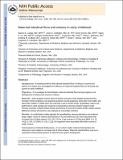| dc.contributor.author | Lange, Nancy | |
| dc.contributor.author | Celedón, Juan C. | |
| dc.contributor.author | Forno, Erick | |
| dc.contributor.author | Ly, Ngoc P. | |
| dc.contributor.author | Onderdonk, Andrew Bruce | |
| dc.contributor.author | Bry, Lynn | |
| dc.contributor.author | Delaney, Mary Louise Rodriguez | |
| dc.contributor.author | DuBois, Andrea M. | |
| dc.contributor.author | Gold, Diane R. | |
| dc.contributor.author | Weiss, Scott Tillman | |
| dc.contributor.author | Litonjua, Augusto Ampil | |
| dc.date.accessioned | 2016-05-17T15:06:21Z | |
| dc.date.issued | 2011 | |
| dc.identifier.citation | Lange, Nancy E., Juan C. Celedón, Erick Forno, Ngoc P. Ly, Andrew Onderdonk, Lynn Bry, Mary L. Delaney, et al. 2011. Maternal intestinal flora and wheeze in early childhood. Clinical & Experimental Allergy 42, no. 6: 901-908. doi:10.1111/j.1365-2222.2011.03950.x. | en_US |
| dc.identifier.issn | 0954-7894 | en_US |
| dc.identifier.uri | http://nrs.harvard.edu/urn-3:HUL.InstRepos:27005693 | |
| dc.description.abstract | Background:
Increasing evidence links altered intestinal flora in infancy to eczema and asthma. No studies have investigated the influence of maternal intestinal flora on wheezing and eczema in early childhood.
Objective:
To investigate the link between maternal intestinal flora during pregnancy and development of wheeze and eczema in infancy.
Methods:
Sixty pregnant women from the Boston area gave stool samples during the third trimester of their pregnancy and answered questions during pregnancy about their own health, and about their children’s health when the child was 2 and 6 months of age. Quantitative culture was performed on stool samples and measured in log10colony-forming units(CFU)/gram stool. Primary outcomes included infant wheeze and eczema in the first 6 months of life. Atopic wheeze, defined as wheeze and eczema, was analyzed as a secondary outcome.
Results:
In multivariate models adjusted for breastfeeding, daycare attendance and maternal atopy, higher counts of maternal total aerobes (TA) and enterococci (E) were associated with increased risk of infant wheeze (TA: OR 2.32 for 1 log increase in CFU/g stool [95% CI 1.22, 4.42]; E: OR 1.57 [95% CI 1.06, 2.31]). No organisms were associated with either eczema or atopic wheeze.
Conclusions & Clinical Relevance:
In our cohort, higher maternal total aerobes and enterococci were related to increased risk of infant wheeze. Maternal intestinal flora may be an important environmental exposure in early immune system development. | en_US |
| dc.language.iso | en_US | en_US |
| dc.publisher | Wiley-Blackwell | en_US |
| dc.relation.isversionof | doi:10.1111/j.1365-2222.2011.03950.x | en_US |
| dc.relation.hasversion | http://www.ncbi.nlm.nih.gov/pmc/articles/PMC3428746/ | en_US |
| dash.license | LAA | |
| dc.subject | infant wheeze | en_US |
| dc.subject | eczema | en_US |
| dc.subject | mircobiota | en_US |
| dc.subject | intestinal flora | en_US |
| dc.subject | maternal flora | en_US |
| dc.title | Maternal intestinal flora and wheeze in early childhood | en_US |
| dc.type | Journal Article | en_US |
| dc.description.version | Accepted Manuscript | en_US |
| dc.relation.journal | Clinical & Experimental Allergy | en_US |
| dash.depositing.author | Weiss, Scott Tillman | |
| dc.date.available | 2016-05-17T15:06:21Z | |
| dc.identifier.doi | 10.1111/j.1365-2222.2011.03950.x | * |
| dash.authorsordered | false | |
| dash.contributor.affiliated | Bry, Lynn | |
| dash.contributor.affiliated | Lange, Nancy E | |
| dash.contributor.affiliated | Delaney, Mary | |
| dash.contributor.affiliated | Onderdonk, Andrew | |
| dash.contributor.affiliated | Gold, Diane | |
| dash.contributor.affiliated | Litonjua, Augusto A. | |
| dash.contributor.affiliated | Weiss, Scott | |


